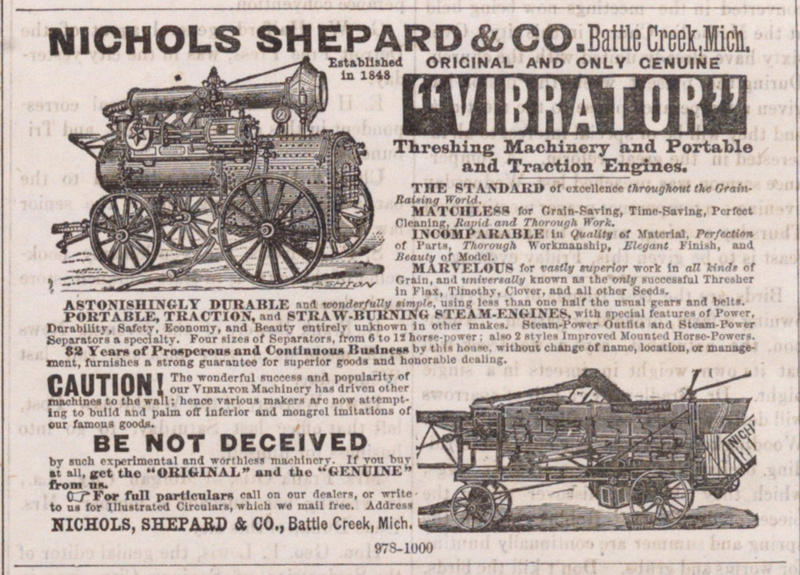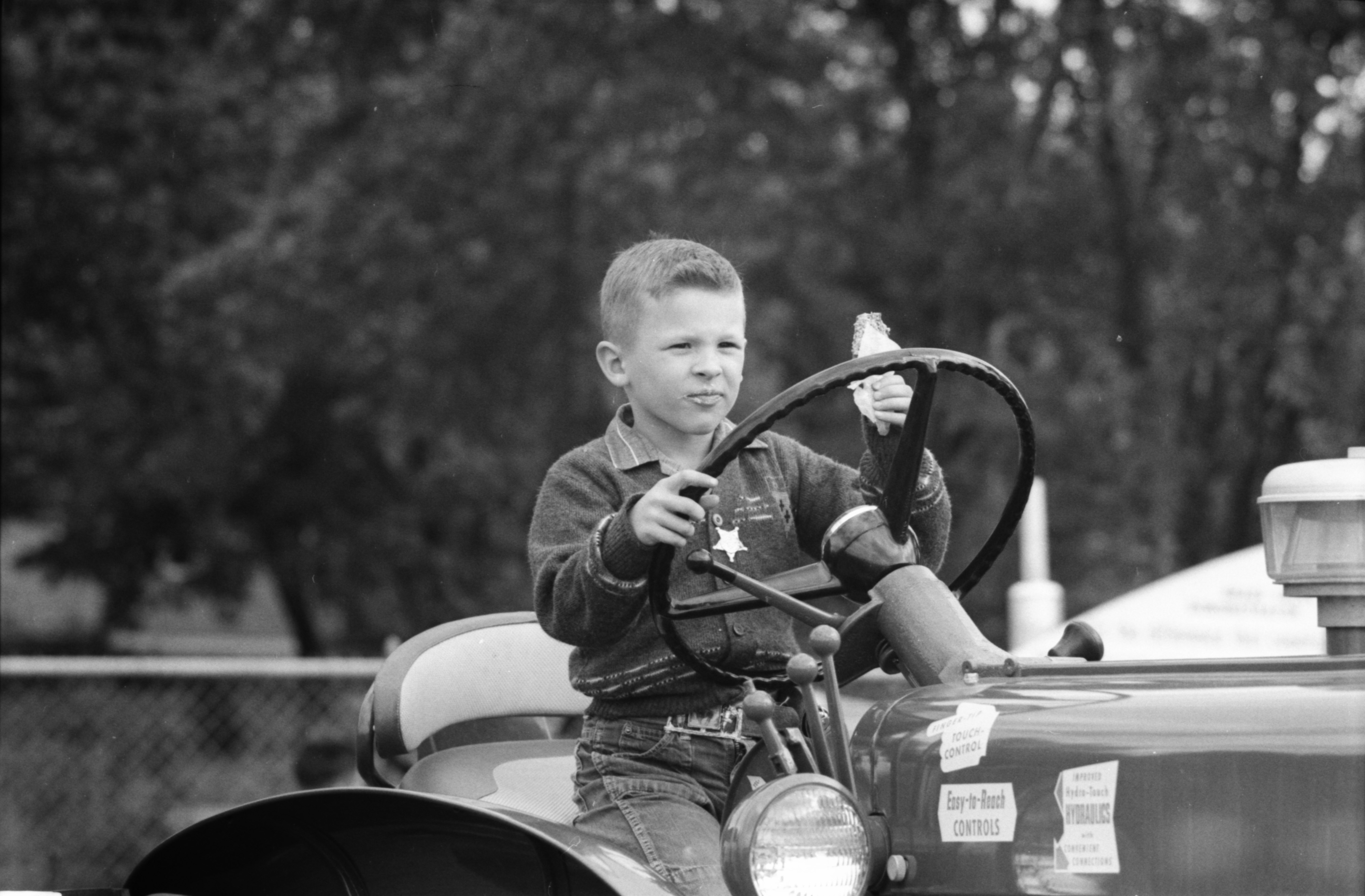Nichols Shepard & Co.

Parent Issue
Day
23
Month
April
Year
1880
Copyright
Public Domain
- Read more about Nichols Shepard & Co.
- Log in or register to post comments
Nichols Shepard & Co.

Parent Issue
Day
26
Month
March
Year
1880
Copyright
Public Domain
- Read more about Nichols Shepard & Co.
- Log in or register to post comments
Nichols Shepard & Co.

Parent Issue
Day
19
Month
March
Year
1880
Copyright
Public Domain
- Read more about Nichols Shepard & Co.
- Log in or register to post comments
Classified_ad

Parent Issue
Day
6
Month
February
Year
1880
Copyright
Public Domain
- Read more about Classified_ad
- Log in or register to post comments
Boy on a Tractor at the Saline Fair

Year:
1958
Copyright
Copyright Protected
- Read more about Boy on a Tractor at the Saline Fair
- Log in or register to post comments
Boy and Girl on a Farmall Tractor at the Saline Fair

Year:
1958
Copyright
Copyright Protected
- Read more about Boy and Girl on a Farmall Tractor at the Saline Fair
- Log in or register to post comments
Grain Cutting After Storm: Bolgos Photographer: Eck Stanger

Year:
1935
Published In:
Ann Arbor News, August 14, 1935
Caption:
Rains Play Havoc With Oats Crop: The condition of the oats crop in Washtenaw county is well illustrated by the scene, pictured above, taken Monday on the Bolgos creamery farm, Plymouth road where four men, using a tractor and binder are trying to salvage as much of the crop as possible. Rains of the recent weeks had beaten the uncut grain to the ground. Many farmers are turning their sheep into their oats fields or seeding them to clover, rather than undertaking the well-nigh hopeless task of recovering the grain. The loss of grain in a field such as that shown above runs from one fifth to one half, even when the greatest care is taken, as it was in this instance.
Ann Arbor News, August 14, 1935
Caption:
Rains Play Havoc With Oats Crop: The condition of the oats crop in Washtenaw county is well illustrated by the scene, pictured above, taken Monday on the Bolgos creamery farm, Plymouth road where four men, using a tractor and binder are trying to salvage as much of the crop as possible. Rains of the recent weeks had beaten the uncut grain to the ground. Many farmers are turning their sheep into their oats fields or seeding them to clover, rather than undertaking the well-nigh hopeless task of recovering the grain. The loss of grain in a field such as that shown above runs from one fifth to one half, even when the greatest care is taken, as it was in this instance.
Copyright
Copyright Protected
- Read more about Grain Cutting After Storm: Bolgos
- Log in or register to post comments
Arthur Heath Harvests Wheat, August 1935 Photographer: Eck Stanger

Year:
1935
Published In:
Ann Arbor News, August 7, 1935
Caption:
Harvesting of wheat on the grand scale, with tractor-drawn "combines" cutting and threshing the grain in a multiple operation, is not confined, as is popularly supposed, to the broad wheat lands of Minnesota and the Dakotas. Each summer, Arthur Heath, farmer living two miles southwest of Milan, harvests his own and some of his neighbors' wheat crops with the combine, pictured above. Horse-drawn wagons are used to haul the sacks of wheat to the barn. That is the only concession to old-fashioned methods of wheat harvesting.
Ann Arbor News, August 7, 1935
Caption:
Harvesting of wheat on the grand scale, with tractor-drawn "combines" cutting and threshing the grain in a multiple operation, is not confined, as is popularly supposed, to the broad wheat lands of Minnesota and the Dakotas. Each summer, Arthur Heath, farmer living two miles southwest of Milan, harvests his own and some of his neighbors' wheat crops with the combine, pictured above. Horse-drawn wagons are used to haul the sacks of wheat to the barn. That is the only concession to old-fashioned methods of wheat harvesting.
Copyright
Copyright Protected
- Read more about Arthur Heath Harvests Wheat, August 1935
- Log in or register to post comments
Whitmore Lake: Owen Steffe of Whitmore Lake is using Big-Scale Haying Methods to gather in a crop of 125 acres of alfalfa hay on the Huron Valley farms on Whitmore Lake Rd. Photographer: Eck Stanger

Year:
1935
Published In:
Ann Arbor News, July 17, 1935
Caption:
Steffe Uses Big-Scale Haying Methods: Above are pictured the hay rake and stacker, said by local farm authorities to be the only combination of its kind operating in Michigan, which Owen Steffe of Whitmore Lake is using to gather in a crop of 125 acres of alfalfa hay on the Huron Valley farms on Whitmore Lake Rd. During the season he uses it on a number of farms for which he harvests all the hay grown. This strange combination consists of a huge rake drawn by two horses hitched individually at the two ends and a huge mechanical arm which scoops up a young haystack at one swoop and hoists it up on the growing stack. The crop shown in the picture above is running about two tons to the acre of exceptionally fine hay.
Ann Arbor News, July 17, 1935
Caption:
Steffe Uses Big-Scale Haying Methods: Above are pictured the hay rake and stacker, said by local farm authorities to be the only combination of its kind operating in Michigan, which Owen Steffe of Whitmore Lake is using to gather in a crop of 125 acres of alfalfa hay on the Huron Valley farms on Whitmore Lake Rd. During the season he uses it on a number of farms for which he harvests all the hay grown. This strange combination consists of a huge rake drawn by two horses hitched individually at the two ends and a huge mechanical arm which scoops up a young haystack at one swoop and hoists it up on the growing stack. The crop shown in the picture above is running about two tons to the acre of exceptionally fine hay.
Copyright
Copyright Protected
Whitmore Lake: Owen Steffe of Whitmore Lake is using Big-Scale Haying Methods to gather in a crop of 125 acres of alfalfa hay on the Huron Valley farms on Whitmore Lake Rd. Photographer: Eck Stanger

Year:
1935
Published In:
Ann Arbor News, July 17, 1935
Caption:
Steffe Uses Big-Scale Haying Methods: Above are pictured the hay rake and stacker, said by local farm authorities to be the only combination of its kind operating in Michigan, which Owen Steffe of Whitmore Lake is using to gather in a crop of 125 acres of alfalfa hay on the Huron Valley farms on Whitmore Lake Rd. During the season he uses it on a number of farms for which he harvests all the hay grown. This strange combination consists of a huge rake drawn by two horses hitched individually at the two ends and a huge mechanical arm which scoops up a young haystack at one swoop and hoists it up on the growing stack. The crop shown in the picture above is running about two tons to the acre of exceptionally fine hay.
Ann Arbor News, July 17, 1935
Caption:
Steffe Uses Big-Scale Haying Methods: Above are pictured the hay rake and stacker, said by local farm authorities to be the only combination of its kind operating in Michigan, which Owen Steffe of Whitmore Lake is using to gather in a crop of 125 acres of alfalfa hay on the Huron Valley farms on Whitmore Lake Rd. During the season he uses it on a number of farms for which he harvests all the hay grown. This strange combination consists of a huge rake drawn by two horses hitched individually at the two ends and a huge mechanical arm which scoops up a young haystack at one swoop and hoists it up on the growing stack. The crop shown in the picture above is running about two tons to the acre of exceptionally fine hay.
Copyright
Copyright Protected